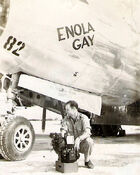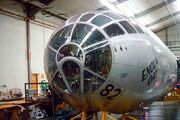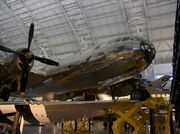|
B-29 (Enola Gay) 44-86292
| |
|
Serial #:
|
44-86292
|
|
Model:
|
B-29A MO Martin-Omaha
|
|
Current Location
|
Steven F. Udvar-Hazy Center
|
|
Status:
|
Displayed
|
B-29 MO Martin-Omaha
The B-29 known as ENOLA GAY is a Silverplate" (atomic bomb carrier) conversion.National Air and Space Museum / Paul Garber Restoration and Storage Facility, Maryland.
509th Composite Group aircraft.
It is a Boeing B-29 Superfortress bomber, named after Enola Gay Tibbets, mother of the pilot, then-Colonel (later Brigadier General) Paul Tibbets. On 6 August 1945, during the final stages of World War II, it became the first aircraft to drop an atomic bomb as a weapon of war. The bomb, code-named "Little Boy", was targeted at the city of Hiroshima, Japan, and caused extensive destruction.
The Enola Gay gained additional attention in 1995 when the cockpit and nose section of the aircraft were exhibited during the bombing's 50th anniversary at the National Air and Space Museum (NASM) of the Smithsonian Institution in downtown Washington, D.C. The exhibit was changed due to a controversy over original historical script displayed with the aircraft. Since 2003, the entire restored B-29 has been on display at NASM's Steven F. Udvar-Hazy Center.
World War II[]
The Enola Gay (B-29-45-MO, AAF Serial Number 44-86292, Victor number 82) was built by the Glenn L. Martin Company (now Lockheed Martin) at its Bellevue, Nebraska, plant, at what is now known as Offutt Air Force Base, and was one of 15 B-29s with the "Silverplate" modifications necessary to deliver atomic weapons, which included an extensively modified bomb bay with pneumatic doors, special propellors, modified engines and the deletion of protective armor and gun turrets. Enola Gay was personally selected by Colonel Paul W. Tibbets, Jr., commander of the 509th Composite Group, on May 9, 1945, while still on the assembly line.
The aircraft was accepted by the USAAF on May 18, 1945 and assigned to the 393d Bombardment Squadron, Heavy, 509th Composite Group. Crew B-9 (Captain Robert A. Lewis, aircraft commander) took delivery of the bomber and flew it from Omaha to the 509th's base at Wendover Army Air Field, Utah on 14 June 1945. Thirteen days later, the aircraft left Wendover for Guam, where it received a bomb bay modification and flew to North Field, Tinian on 6 July. It was originally given the Victor (squadron-assigned identification) number "12," but on 1 August, was given the circle R tail markings of the 6th Bomb Group as a security measure and had its Victor changed to "82" to avoid misidentification with actual 6th BG aircraft. During July of that year, after the bomber flew eight training missions and two combat missions to drop pumpkin bombs on industrial targets at Kobe and Nagoya, Enola Gay was used on 31 July on a rehearsal flight for the actual mission. The partially-assembled Little Boy combat weapon L-11 was contained inside a 41” x 47” x 138” wood crate weighing that was secured to the deck of the USS Indianapolis. Unlike the six U-235 target discs, which were later flown to Tinian on three separate aircraft arriving 28 and 29 July, the assembled projectile with the nine U-235 rings installed was shipped in a single lead-lined steel container weighing that was securely locked to brackets welded to the deck of Captain Charles McVay’s quarters.Both the L-11 and projectile were dropped off at Tinian on 26 July 1945.

Enola Gay returning from it's Hiroshima mission, entering hard-stand. It is in its 6th BG livery, victor number 82 visible on fuselage just forward of the tail fin.
On 5 August 1945, during preparation for the first atomic mission, pilot Colonel Paul Tibbets who assumed command of the aircraft, named the B-29 aircraft after his mother, Enola Gay Tibbets (1893–1983), who had been named for the heroine of a novel. According to Gordon Thomas and Max Morgan-Witts, regularly assigned aircraft commander Robert Lewis was unhappy to be displaced by Tibbets for this important mission, and became furious when he arrived at the aircraft on the morning of 6 August to see it painted with the now famous nose art. Tibbets himself, interviewed on Tinian later that day by war correspondents, confessed that he was a bit embarrassed at having attached his mother's name to such a fateful mission.
The Hiroshima mission had been described by Gordon Thomas and Max Morgan Witts in Enola Gay book as tactically flawless, and Enola Gay returned safely to its base on Tinian to great fanfare on the base. The Enola Gay was accompanied by two other B-29s, Necessary Evil which was used to carry scientific observers, and as a camera plane to photograph the explosion and effects of the bomb and The Great Artiste instrumented for blast measurement.
The first atomic bombing was followed three days later by another B-29 (Bockscar) (piloted by Major Charles W. Sweeney) which dropped a second nuclear weapon, "Fat Man", on Nagasaki. The Nagasaki mission, by contrast, had been described as tactically botched, although the mission had met its objectives. The crew encountered a number of problems in execution, and Bockscar had very little fuel by the time it landed on Okinawa. On that mission, Enola Gay, flown by Crew B-10 (Capt. George Marquardt, aircraft commander, see Necessary Evil for crew details), was the weather reconnaissance aircraft for Kokura.
Mission personnel[]

Bombardier Thomas Ferebee with the Norden Bombsight on Tinian after the dropping of Little Boy
Enola Gay's crew on 6 August 1945, consisted of 12 men. Only three, Tibbetts, Ferebee, and Parsons, knew the purpose of the mission.
(Asterisks denote regular crewmen of the Enola Gay.)
- Colonel Paul W. Tibbets, Jr. (1915-2007) – Pilot and Aircraft commander
- Captain Robert A. Lewis (1917-1983) – Co-pilot; Enola Gay's assigned aircraft commander*
- Major Thomas Ferebee (1918–2000) – Bombardier; replaced regular crewman Donald Orrphin.
- Captain Theodore "Dutch" Van Kirk (1921-) – Navigator
- U.S. Navy Captain William S. "Deak" Parsons (1901–1953) – Weaponeer and bomb commander.
- Lieutenant Jacob Beser (1921–1992) – Radar countermeasures (also the only man to fly on both of the nuclear bombing aircraft)
- Second Lieutenant Morris R. Jeppson (1922–2010) – Assistant weaponeer
- Technical Sergeant George R. "Bob" Caron (1919-1995) – Tail gunner*
- Technical Sergeant Wyatt E. Duzenberry – Flight engineer*
- Sergeant Joe S. Stiborik (1914-1984) – Radar operator*
- Sergeant Robert H. Shumard (1920-1967) – Assistant flight engineer*
- Private First Class Richard H. Nelson (1925-2003) – VHF radio operator*
Subsequent history[]

Enola Gay in the Smithsonian storage facility at Suitland, 1987
On 6 November 1945, Lewis flew the Enola Gay back to the United States, arriving at the 509th's new base at Roswell Army Air Field, New Mexico, on 8 November. On 29 April 1946, Enola Gay left Roswell as part of Operation Crossroads and flew to Kwajalein on May 1st. It was not chosen to make the test drop at Bikini Atoll and left Kwajalein on 1 July, the date of the test, and reached Fairfield-Suisun Army Air Field, California, the next day.
The decision was made to preserve the Enola Gay, and on 24 July 1946, the aircraft was flown to Davis-Monthan Air Force Base, Arizona, in preparation for storage. On 30 August 1946, the title to the aircraft was transferred to the Smithsonian Institution and the Enola Gay was removed from the USAAF inventory. From 1946 to 1961, the Enola Gay was put into temporary storage at a number of locations:
- 1 September 1946: Davis-Monthan AFB.
- 3 July 1949: Orchard Place Air Field, Park Ridge, Illinois, flown there by Brig Gen Tibbets for acceptance by the Smithsonian.
- 12 January 1952: Pyote Air Force Base, Texas, moved after O'Hare International Airport's location was announced.
- 2 December 1953: Andrews Air Force Base, Maryland.
- 10 August 1960: disassembly at Andrews AFB begun by personnel of the Smithsonian.
- 21 July 1961: components transported to the Smithsonian storage facility at Suitland, Maryland.
Restoration of the bomber began on 5 December 1984, at the Paul E. Garber Preservation, Restoration, and Storage Facility in Suitland-Silver Hill, Maryland.
The propellers that were used on the bombing mission were later shipped to Texas A&M University. One of these propellers was trimmed to 12½ ft for use in the university's Oran W. Nicks Low Speed Wind Tunnel. The lightweight aluminum variable pitch propeller is powered by a 1,250 kVA electric motor providing a wind speed up to 200 mph.
Restoration[]
Exhibition controversy[]
Enola Gay became the center of a controversy at the Smithsonian Institution, when the museum planned to put its fuselage on public display as part of an exhibit commemorating the 50th anniversary of the atomic bombing of Hiroshima. The exhibit, The Crossroads: The End of World War II, the Atomic Bomb and the Cold War, was drafted by the Smithsonian's National Air and Space Museum staff, and arranged around the restored Enola Gay.
Critics of the planned exhibit, especially those of the American Legion and the Air Force Association, charged that the exhibit focused too much attention on the Japanese casualties inflicted by the nuclear bomb, rather than on the motivations for the bombing or the discussion of the bomb's role in ending the World War II conflict with Japan. The exhibit brought to national attention many long-standing academic and political issues related to retrospective views of the bombings. As a result, after various failed attempts to revise the exhibit in order to meet the satisfaction of competing interest groups, the exhibit was canceled on 30 January 1995. Martin O. Harwit, Director of the National Air and Space Museum, was compelled to resign over the controversy.
The forward fuselage did go on display on 28 June 1995. On 2 July 1995, three people were arrested for throwing ash and human blood on the aircraft's fuselage, following an earlier incident in which a protester had thrown red paint over the gallery's carpeting.
On 18 May 1998, the fuselage was returned to the Garber Facility for final restoration.
Complete restoration and display[]

Enola Gay in 2004 at the Steven F. Udvar-Hazy Center
Restoration work began in 1984, and would eventually require 300,000 staff hours. While the fuselage was on display, from 1995 to 1998, work continued on the remaining unrestored components. The aircraft was shipped in pieces to the National Air and Space Museum's Steven F. Udvar-Hazy Center in Chantilly, Virginia from March–June 2003, with the fuselage and wings reunited for the first time since 1960 on 10 April 2003 and assembly completed on 8 August 2003. The aircraft is currently at Washington Dulles International Airport in the Steven F. Udvar-Hazy Center, since the museum annex opened on 15 December 2003.












